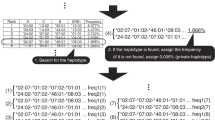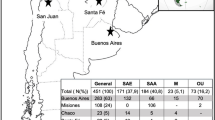Abstract
A comprehensive analysis of the HLA-D region loci, DRB1, DRB3, DRB5, DQA1, DQB1, DPA1 and DPB1, was performed to determine allelic diversity and underlying HLA disparity in 1259 bone marrow recipients and their unrelated donors transplanted through the National Marrow Donor Program. Although 43.0% of DRB1 alleles known to exist at the beginning of the study were found in this predominantly Caucasian transplant population, a few alleles predominated at each locus. In recipients, 67.1% of DRB1 alleles identified were one or two of six common DRB1 alleles. Only 118 (9.4%) donor–recipient pairs were matched for all alleles of DRB1, DQA1, DQB1, DPA1 and DPB1. While 79.4% of the pairs were matched for DRB1, only 13.2% were matched for DPB1 alleles. Almost 66% of pairs differed by more than one allele mismatch and 59.0% differed at more than one HLA-D locus. DQB1 was matched in 85.9% of DRB1-matched pairs. In contrast, only 13.9% of the pairs matched for DRB1, DQA1 and DQB1 were also matched for DPA1 and DPB1. This database, highlighting the underlying HLA disparity within the pairs, forms the foundation of an ongoing study to establish the relationship between HLA matching and successful outcome in unrelated allogeneic stem cell transplant. Bone Marrow Transplantation (2000) 25, 385–393.
This is a preview of subscription content, access via your institution
Access options
Subscribe to this journal
Receive 12 print issues and online access
$259.00 per year
only $21.58 per issue
Buy this article
- Purchase on Springer Link
- Instant access to full article PDF
Prices may be subject to local taxes which are calculated during checkout


Similar content being viewed by others
References
Devergie A, Apperley JF, Labopin M et al. European results of matched unrelated donor bone marrow transplantation for chronic myeloid leukemia. Impact of HLA class II matching. Chronic Leukemia Working Party of the European Group for Blood and Marrow Transplantation Bone Marrow Transplant 1997 20: 11–19
Davies SM, Shu XO, Blazar BR et al. Unrelated donor bone marrow transplantation: influence of HLA A and B incompatibility on outcome Blood 1995 86: 1636–1642
Speiser DE, Tiercy JM, Rufer N et al. High resolution HLA matching associated with decreased mortality after unrelated bone marrow transplantation Blood 1996 87: 4455–4462
Anasetti C, Beatty PG, Storb R et al. Effect of HLA incompatibility on graft-versus-host disease, relapse, and survival after marrow transplantation for patients with leukemia or lymphoma Hum Immunol 1990 29: 79–91
Spencer A, Szydlo RM, Brookes PA et al. Bone marrow transplantation for chronic myeloid leukemia with volunteer unrelated donors using ex vivo or in vivo T-cell depletion: major prognostic impact of HLA class I identity between donor and recipient Blood 1995 86: 3590–3597
Hansen JA . Development of registries of HLA-typed volunteer marrow donors Tissue Antigens 1996 47: 460–463
Beatty PG, Mori M, Milford E . Impact of racial genetic polymorphism on the probability of finding an HLA-matched donor Transplantation 1995 60: 778–783
Mori M, Beatty PG, Graves M et al. HLA gene and haplotype frequencies in the North American population – The National Marrow Donor Program Donor Registry Transplantation 1997 64: 1017–1027
Granja CB, Salazar M, Yunis EJ . Population genetics and human leukocyte antigen polymorphism. In: Tilney NL, Strom TB, Paul LC (eds) Transplantation Biology: Cellular and Molecular Aspects Lippincott-Raven Publishers: Philadelphia 1996 pp. 311–325
Bodmer JG, Marsh SGE, Albert ED et al. Nomenclature for factors of the HLA system, 1996 Tissue Antigens 1997 49: 297–321
Petersdorf EW, Longton GM, Anasetti C et al. The significance of HLA-DRB1 matching on clinical outcome after HLA-A, B, DR identical unrelated donor marrow transplantation Blood 1995 86: 1606–1613
Keever CA, Leong N, Cunningham I et al. HLA-B44-directed cytotoxic T cells associated with acute graft-versus-host disease following unrelated bone marrow transplantation Bone Marrow Transplant 1994 14: 137–145
Baxter-Lowe LA, Eckels DD, Ash R et al. The predictive value of HLA-DR oligotyping for MLC responses Transplantation 1992 53: 1352–1357
Mickelson EM, Longton G, Anasetti C et al. Evaluation of the mixed lymphocyte culture (MLC) assay as a method for selecting unrelated donors for marrow transplantation Tissue Antigens 1996 47: 27–36
Perkins HA, Hansen JA . The US National Marrow Donor Program Am J Ped Hematol Oncol 1994 16: 30–34
Imanishi T, Akaza T, Kimura A et al. Allele and haplotype frequencies for HLA and complement loci in various ethnic groups. In: Tsuji K, Aizawa M, Sasazuki T (eds) HLA 1991 vol. 1: Oxford University Press: New York 1992 pp 1065–1220
Bodmer JG, Marsh SGE, Albert ED et al. Nomenclature for factors of the HLA system, 1994 Hum Immunol 1994 41: 1–20
Noreen H, Steiner L, Davidson M et al. Six new DPB1 alleles identified in a study of 1302 unrelated bone marrow donor-recipient pairs Tissue Antigens 1997 49: 512–516
Howard MR, Gore SM, Hows JM et al. A prospective study of factors determining the outcome of unrelated marrow donor searches: report from the International Marrow Unrelated Search and Transplant Study Working Group on behalf of collaborating centres Bone Marrow Transplant 1994 13: 389–396
Klitz W, Stephens JC, Grote M, Carrington M . Discordant patterns of linkage disequilibrium of the peptide-transporter loci within the HLA class II region Am J Hum Genet 1995 57: 1436–1444
Salazar M, Yunis I, Alosco SM et al. HLA-DPB1 allele mismatches between unrelated HLA-A,B,C,DR (generic) DQA1-identical unrelated individuals with unreactive MLC Tissue Antigens 1992 39: 203–208
Begovich AB, McClure GR, Suraj VC et al. Polymorphism, recombination, and linkage disequilibrium within the HLA class II region J Immunol 1992 148: 249–258
Szydlo R, Goldman JM, Klein JP et al. Results of allogeneic bone marrow transplants for leukemia using donors other than HLA-identical siblings J Clin Oncol 1997 15: 1767–1777
Bearman SI, Mori M, Beatty PG et al. Comparison of morbidity and mortality after marrow transplantation from HLA-genotypically identical siblings and HLA-phenotypically identical unrelated donors Bone Marrow Transplant 1994 13: 31–35
Davies SM, Ramsay NKC, Haake RJ et al. Comparison of engraftment in recipients of matched sibling or unrelated donor marrow allografts Bone Marrow Transplant 1994 13: 51–57
Hansen JA, Gooley TA, Martin PJ et al. Bone marrow transplants from unrelated donors for patients with chronic myeloid leukemia New Engl J Med 1998 338: 962–968
Petersdorf EW, Gooley TA, Anasetti C et al. Optimizing outcome after unrelated marrow transplantation by comprehensive matching of HLA class I and II alleles in the donor and recipient Blood 1998 92: 3515–3520
Sasazuki T, Juji T, Morishima Y et al. Effect of matching of class I HLA alleles on clinical outcome after transplantation of hematopoietic stem cells from an unrelated donor New Engl J Med 1998 339: 1177–1185
Petersdorf EW, Longton GM, Anasetti C et al. Definition of HLA-DQ as a transplantation antigen Proc Natl Acad Sci USA 1996 93: 15358–15363
L'Abbé D, Tremblay L, Filion M et al. Alloimmunization to platelet antigen HPA-1a (PIA1) is strongly associated with both HLA-DRB3*0101 and HLA-DQB1*0201 Hum Immunol 1992 34: 107–114
Rosen-Bronson S, Jaraquemada D . On the relative immunogenicity of DR alloantigens: T cell recognition of HLA-DR2a and HLA-DR2b Hum Immunol 1991 30: 215–221
Cotner T, Charbonneau H, Mellins E, Pious D . mRNA abundance, rather than differences in subunit assembly, determine differential expression of HLA-DRβ1 and -DRaβ3 molecules J Biol Chem 1989 264: 11107–11111
Stunz LL, Karr RW, Anderson RA . HLA-DRB1 and -DRB4 genes are differentially regulated at the transcriptional level J Immunol 1989 143: 3081–3086
Kratzin H, Yang CY, Gotz H et al. Primary structure of class II human histocompatibility antigens. 1st communication. Amino acid sequence of the N-terminal 198 residues of the beta chain of a HLA-Dw2,2; DR2,2-alloantigen Hoppe Seylers Z Physiol Chem 1981 362: 1665–1669
Petersdorf EW, Smith AJ, Mickelson EM et al. The role of HLA-DPB1 disparity on the development of acute graft-versus-host disease following unrelated donor marrow transplantation Blood 1993 81: 1923–1932
Potolicchio I, Brookes PA, Madrigal A et al. HLA-DPB1 mismatch at position 69 is associated with high helper T lymphocyte precursor frequencies in unrelated bone marrow transplant pairs Transplantation 1996 62: 1347–1352
Petersdorf EW, Longton GM, Anasetti C et al. Association of HLA-C disparity with graft failure after marrow transplantation from unrelated donors Blood 1997 89: 1818–1823
Acknowledgements
This research has been supported by funding from the Office of Naval Research N00014–93–1-0658 to National Marrow Donor Program and N00014–92-J-4036 and N00014–94–1-0049 to the CW Bill Young Marrow Donor Recruitment and Research Program. The views expressed in this article are those of the authors and do not reflect the official policy or position of the Department of the Navy, the Department of Defense, or the US government. We would like to acknowledge the assistance of the NMDP Transplant and Donors Centers in providing cells and data for this study, the DNA-based registry typing laboratories for their assistance in determining the preliminary DRB and DQB1 typing of the samples, and our laboratory staff and NMDP personnel for their assistance with the HLA typing and data analysis. Dr Bo Dupont was instrumental in the original design of this project and oversight was provided by the NMDP Histocompatibility Committee. This manuscript is dedicated to the memory of our friend and colleague, Michael Chopek, MD. Dr Chopek participated in the early phases of the design, data collection and analysis of this project. His enthusiasm and commitment have inspired us and we are saddened that he was unable to see this work come to fruition.
Author information
Authors and Affiliations
Rights and permissions
About this article
Cite this article
Hurley, C., Baxter-Lowe, L., Begovich, A. et al. The extent of HLA class II allele level disparity in unrelated bone marrow transplantation: analysis of 1259 National Marrow Donor Program donor–recipient pairs. Bone Marrow Transplant 25, 385–393 (2000). https://doi.org/10.1038/sj.bmt.1702161
Received:
Accepted:
Published:
Issue Date:
DOI: https://doi.org/10.1038/sj.bmt.1702161
Keywords
This article is cited by
-
Diverging effects of HLA–DPB1 matching status on outcome following unrelated donor transplantation depending on disease stage and the degree of matching for other HLA alleles
Leukemia (2010)
-
The probability of identifying a 10/10 HLA allele-matched unrelated donor is highly predictable
Bone Marrow Transplantation (2007)
-
Greffes allogéniques à partir de donneurs non apparentés
Oncologie (2007)
-
Impact of HLA matching on outcome of hematopoietic stem cell transplantation in children with inherited diseases: a single-center comparative analysis of genoidentical, haploidentical or unrelated donors
Bone Marrow Transplantation (2004)
-
The degree of matching at HLA-DPB1 predicts for acute graft-versus-host disease and disease relapse following haematopoietic stem cell transplantation
Bone Marrow Transplantation (2003)



